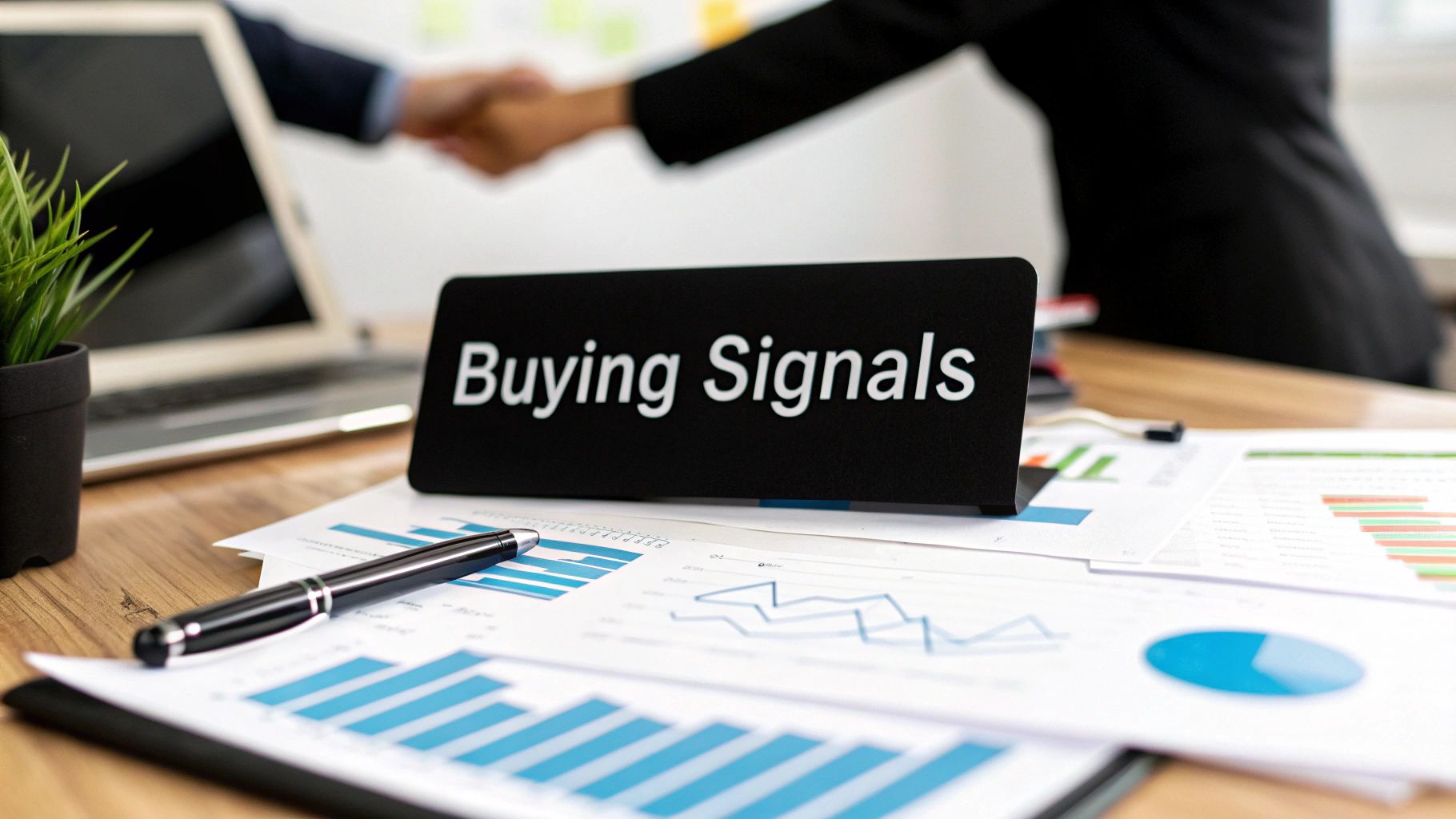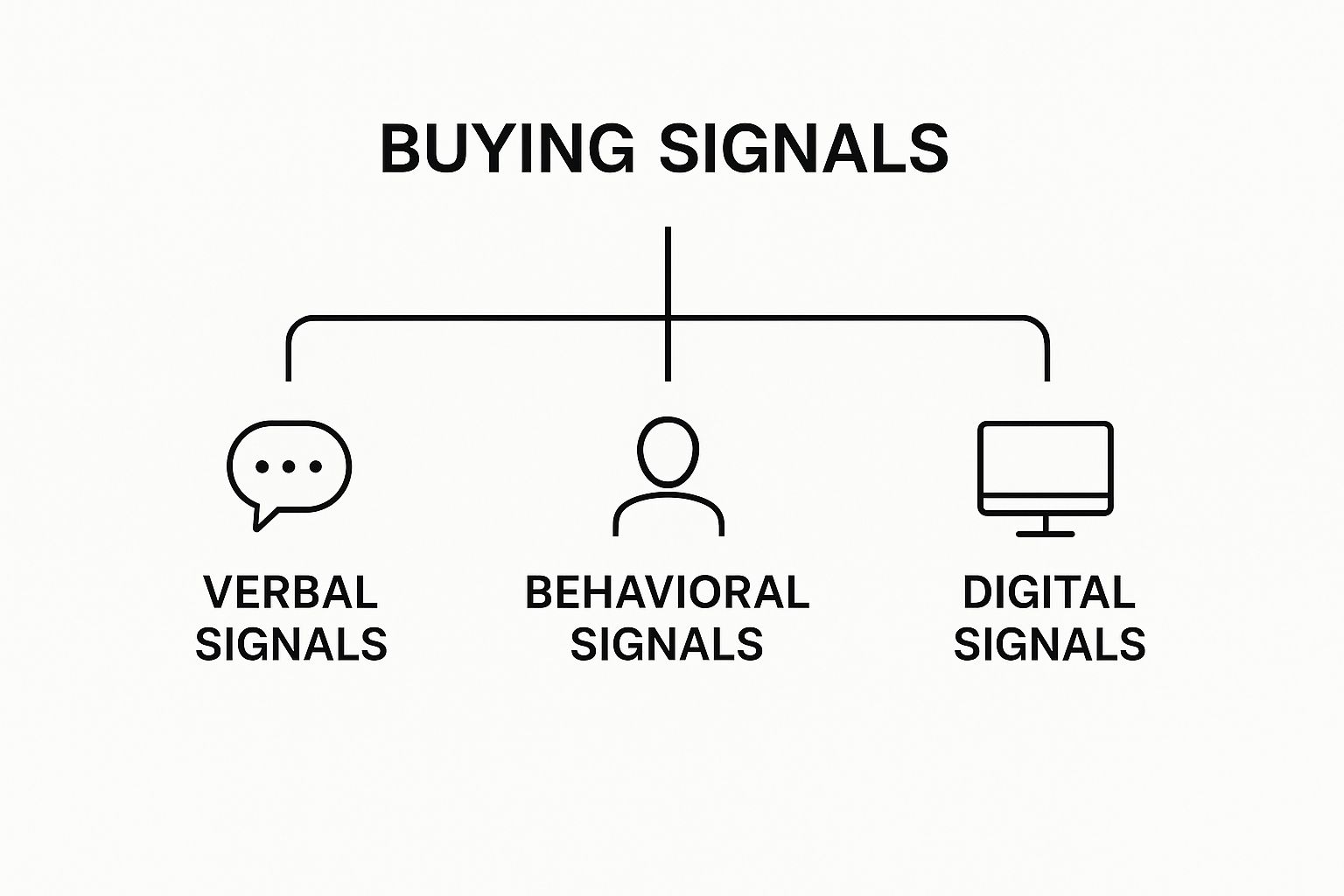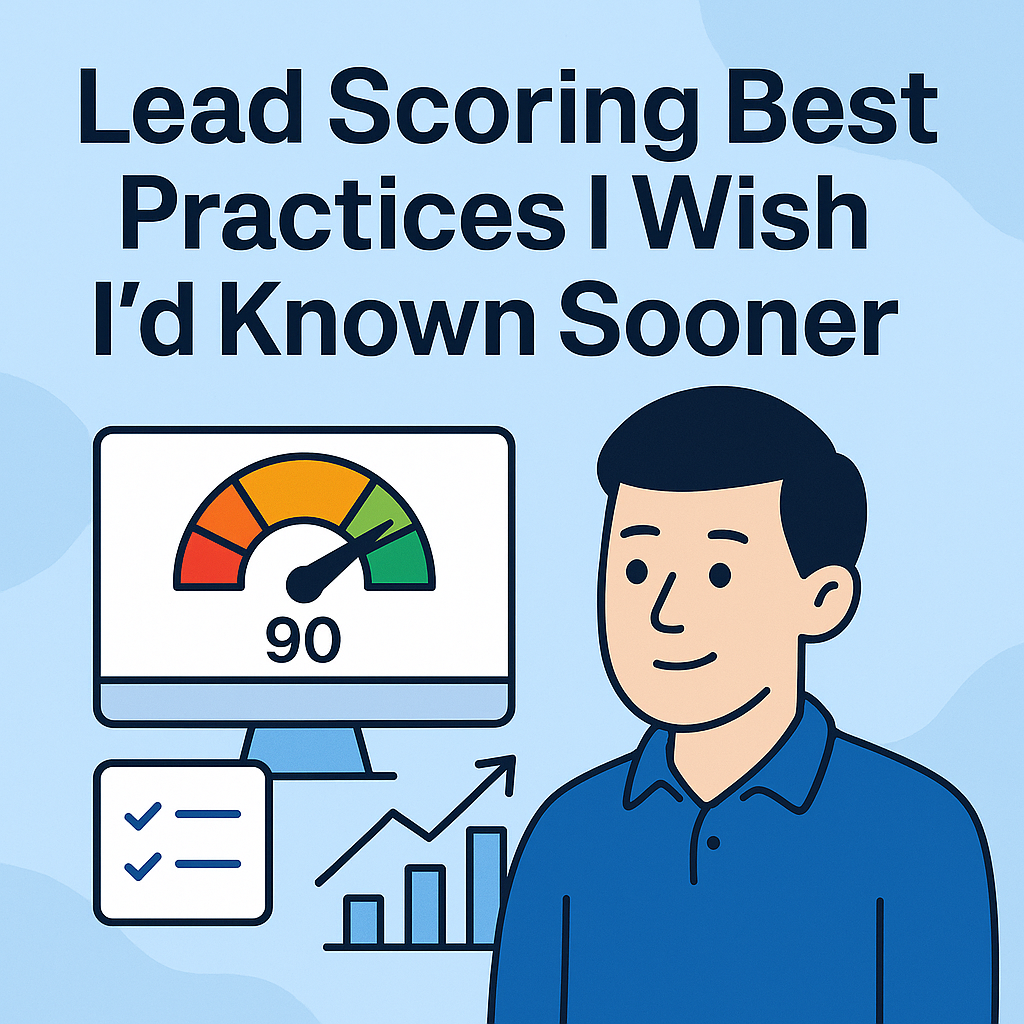What Are Buying Signals? My Fail-Proof Guide to Spotting Customer Intent and Closing Deals Faster

Ever felt that sinking feeling when a deal you were sure was set… disappears? Poof. Ghosted. It’s beyond frustrating, and 9 times out of 10, it’s because we missed what the prospect was telling us between the lines. Those little clues they drop, such as questions, comments, and digital footprints, are buying signals. They're the green lights in a sales conversation, begging you to hit the accelerator.
Think of them as the "tells" in a poker game. If you know what to look for, you'll know exactly when to go all-in.
So, What Exactly Are Buying Signals?
I learned this the hard way early in my career. I was working on a pitch for a six-figure contract, so focused on my script that I completely steamrolled the prospect's real concern. They kept circling back to one question: "How would our finance team get the data out?" I saw it as an interruption, and it turned out to be the key to the entire deal. That painful lesson taught me something invaluable: shut up and listen. The customer is telling you exactly how to sell to them.
The 3 Core Types of Buying Signals
So, what do these signals look like in the wild? Forget the academic jargon. They're simply the behaviors that signal a prospect is mentally moving from "What is this?" to "What would it be like to own this?"
These signals generally fall into one of three buckets, which you can start looking for right away.

As the image shows, buying signals aren't just one thing. They're a combination of what someone says (verbal cues), what they do (non-verbal actions), and how they engage with your or other companies online (digital behavior). Understanding all three gives you a much clearer picture of their true intent.
To make this even simpler, here's a quick reference table breaking down these categories.
Quick Guide to Buying Signal Categories
This table is just a starting point. The real art is learning to spot these cues in real-time and string them together to understand the bigger picture of your prospect's journey.
From Casual Questions to Real Intent
Let's be clear: a prospect asking "What does your company do?" is not a buying signal. That's just conversation. A true buying signal emerges when the conversation shifts from information gathering to problem-solving.
The Critical Shift: The biggest mistake reps make is treating every question with the same weight. A general inquiry is an opportunity to educate, but a buying signal is an invitation to guide them toward a decision.
Think about it. A prospect checking your pricing page is a good thing. But what about a prospect who visits the pricing page three times in a week, downloads a case study featuring a competitor, and then signs up for a webinar? That’s not just curiosity. That's a screaming signal that they are deep in the evaluation stage.
The skill you want to build is distinguishing idle chatter from genuine purchase intent. It’s all about noticing when the questions change from "What is it?" to "How would we use it?" Once you can hear that shift, you're on your way to closing more deals, faster. Ready to learn how to spot them? Let's dive in.
Verbal Cues That Signal a Green Light
Alright, let's talk about sharpening your most powerful sales tool: your ears. Prospects drop verbal buying signals all the time, but they're incredibly easy to miss if you’re waiting for your turn to talk. I’ve been there, nodding along while my brain is just screaming, "What's my next line?!" Big mistake. The real gold is in their words, not yours.
Think of it this way: when a prospect starts asking specific questions, they are mentally test-driving your product. Their language shifts from curiosity to visualization. These aren't just questions; they're invitations.
Future-Pacing and Ownership Language
One of the most potent verbal cues is when a prospect starts speaking about the future with your product in it. This is called future-pacing. They're no longer asking "What does it do?" but "How will it work for us?"
Listen for phrases that start with:
- "So, my team would use this dashboard to..."
- "How soon could we get this implemented?"
- "In Q3, we plan to... would this support that?"
Early in my sales career, I had a prospect ask, "So, your reporting would replace our Monday morning spreadsheet marathon, right?" I just said "Yes" and moved on. What I should have done was pause and dig in: "Absolutely, kindly tell me more about that Monday meeting. Who builds that spreadsheet, and how much time would they get back?" See the difference? I missed a golden opportunity to anchor the value.
Detailed Logistical Questions
When questions get granular, you know you're on the right track. These are the details people only care about when they're seriously considering a purchase.
Pro Tip: When a prospect asks about the small stuff, it's a huge signal. It means they've moved past the big-picture "if" and are now working through the "how."
Here’s what to listen for:
- Integration Questions: "Does this integrate with Salesforce?" or "How does it connect to our accounting software?" This indicates they need clarity on how your solution fits into their existing ecosystem.
- Pricing Specifics: Not just "How much is it?" but "What are the payment terms?" or "Is there a discount for annual plans?" This is a classic buying signal that they're trying to fit your cost into their budget.
- Onboarding and Support: "What does the onboarding process look like?" or "Who would be our main point of contact for support?" These questions signal they are picturing themselves as a customer who will need help down the line.
What to do when you hear these signals?
Don't just answer and move on. Use it as a pivot. When they ask about integration, respond and then ask, "Great question. It seems making sure this works smoothly with your current tools is a top priority. Is that right?"
This simple step confirms the signal, makes the prospect feel heard, and naturally moves the conversation toward closing. It’s not about being pushy; it’s about being an attentive guide leading them to the solution they're already asking for.
Spotting Non-Verbal and Digital Buying Signals
In sales, actions will always speak louder than words. What a prospect does is often a far more reliable sign of their true intent than what they say. I once had a prospect tell me, "We're just exploring options," while simultaneously taking meticulous notes and nodding along with every single value proposition. Their words said "maybe later," but their body language was screaming "tell me more!"
This is exactly why understanding non-verbal and digital buying signals becomes your secret weapon. These are the silent, yet powerful cues that reveal genuine engagement.
Reading the Room (Even on Zoom)
Whether you're in a face-to-face meeting or on a video call, non-verbal cues are pure gold. Are they leaning in when you start talking about a key feature? That's a classic sign of interest. Are they nodding enthusiastically, or even better, are other stakeholders on the call starting to nod along with them? Bingo.
Keep an eye out for these subtle but powerful actions:
- Taking Detailed Notes: This isn't just someone being polite. When a prospect starts writing down the specifics of implementation or pricing, they are actively building a case for your solution to use internally.
- Active Engagement: They aren't multitasking or scrolling on their phone. They maintain eye contact and are genuinely present in the conversation.
- Positive Body Language: Beyond just nodding, look for open posture (think uncrossed arms) and mirroring your positive gestures. It's a subconscious signal that you're building real rapport.
But what about the signals you can't see? In today's sales world, some of the most potent clues are the digital breadcrumbs they leave behind.
Following the Digital Breadcrumbs
Tracking a prospect's online behavior reveals invaluable insights into their interests. These digital footprints are clear indicators of engagement. A study by Gartner indicates that by 2025, 80% of B2B sales interactions will occur through online channels, highlighting the importance of recognizing these signals.
Consider this: which signal holds more weight? A prospect casually requesting more information, or that same prospect taking the following actions:
- Visiting your pricing page three times in one day.
- Downloading a technical case study relevant to their industry.
- Forwarding your proposal email to their superior, visible through tracking tools.
- Adding multiple team members to a free trial account.
These actions are not random clicks but a series of high-intent behaviors, indicating strong interest without verbal confirmation. For better understanding, explore the 13 intent signals to find high-intent leads.
Recognizing the broader spectrum of digital signals can provide even more context. For example, leads who engage with specific content, such as blog posts or webinars, demonstrate targeted interest. Additionally, monitoring companies that are actively hiring or have recently raised funds can offer clues about their growth and potential needs for your services.
The key is to connect the dots. One digital action may be a hint; a pattern is a clear buying signal that warrants your attention.
Many aspects of this process can be automated. Setting up alerts in your CRM or using tools that track engagement allows you to respond promptly when a prospect shows increased activity. This approach enables timely follow-ups, equipped with insights into their genuine interests. It's not intrusive; it's simply being highly attentive.
How to Respond to a Buying Signal (Without Messing It Up!)
So, you’ve spotted a buying signal.
Maybe your prospect just leaned in and asked, "What are the payment terms?" Your pulse quickens. This is it. This is that key moment where a deal is either won or, as I've unfortunately learned from experience, completely fumbled.

I remember one call where I got so excited by a clear signal that I just blurted out, "Great, so you're buying it then?" The friendly, collaborative vibe instantly turned ice-cold. My mistake? I treated a buying signal like a signed contract.
Here's the thing: a buying signal isn't the finish line. It's more like the final turn on a racetrack. You still have to drive the car home.
The secret is responding with calm confidence, not eager desperation. Your job is to make it incredibly easy for them to say "yes" by smoothly guiding them through the last few steps. It’s a delicate dance; move too fast and you seem pushy; wait too long and you lose all momentum.
The "Do This, Never Do That" Framework
How you react is everything, and it changes depending on the specific signal. Let's walk through a few common scenarios using a simple framework to keep you on the right path.
Scenario 1: The Pricing Question
- The Signal: "What are the payment terms?" or "Is there a discount for paying annually?"
- NEVER Do This: Fire back a pricing sheet and ask, "Which one do you want?" That's lazy. It puts all the work back on your prospect.
- DO THIS: Answer their question directly, then pivot to what’s called a trial close. Try saying, "Great question. We offer both monthly and annual plans, with a 20% discount on annual subscriptions. Assuming we can find a plan that fits your budget, is this the solution you'd like to move forward with?"
Scenario 2: The Logistics Question
- The Signal: "How soon could we get this implemented?"
- NEVER Do This: Give a vague answer like, "Pretty quickly." This kills the energy and shows you aren't prepared.
- DO THIS: Offer a specific, confident answer that helps them visualize success. Respond with something like, "We can typically have new clients fully onboarded in 7-10 business days. If we were to kick things off next week, would that timeline work for your team?"
This approach confirms their interest without being aggressive and, most importantly, keeps you in control of the conversation.
Your Step-by-Step Guide to Responding to Buying Signals
When you spot a strong buying signal, don't panic. Just breathe and follow this simple, three-step process to shift the conversation toward a close.
- Acknowledge and Validate: First, show them you're listening. "That's a great question. It sounds like you're already thinking about how this would work for your team." This simple act of validation makes them feel heard and understood.
- Answer and Isolate: Give a crystal-clear answer to their question. Then, try to isolate it as the final hurdle. For instance: "So, just to confirm, if we could handle that concern you mentioned about data migration, would you be ready to move forward?"
- Propose the Next Step (Ask for the Business): If they give you a positive response, it's go-time. Don't hesitate. Confidently ask for the sale. "Perfect. The next step is to get the agreement sent over. Do you have 5 minutes to walk through it together?"
The key is to lead the prospect to the logical next step. You're not forcing them; you're guiding them. A well-timed follow-up is crucial here. If you want to dive deeper, you should check out our guide on how to master the sales follow-up call using AI to make every interaction count.
Responding to Digital Buying Signals
In today's digital age, buying signals also occur through interactions with content or participation in events. Here's how to handle these signals:
- Engagement with Content: If a lead interacts with your content, such as downloading a whitepaper or watching a webinar, reach out with a personalized message. Acknowledge their interest in the content, and offer to answer any questions they might have or provide additional resources.
- Event Participation: If a prospect attends an event, follow up with a message thanking them for their participation. Also, draw their attention to any key highlights from the event and suggest a meeting to discuss how your solutions can address their needs.
By following this structure, you turn a moment of potential awkwardness into a smooth, professional close. You stop being a reactive salesperson and become a proactive guide. Master this, and it will change your results.
How Buying Signals Work in Financial Markets
Let’s step away from the world of sales calls for a moment and see how buying signals play out on one of the biggest stages imaginable: the financial markets. It might seem like a completely different universe, but the underlying psychology is strikingly similar. For a trader, recognizing a buying signal isn't just about making a good decision; it can mean the difference between riding a massive wave of profit and getting washed out.

Think about a prospect asking, "So, what are your payment terms?" That’s their way of leaning in and signaling serious interest. In the stock market, a classic technical indicator known as the "golden cross" is the market's way of screaming the very same thing. This signal happens when a short-term moving average (like the 50-day) climbs above a long-term one (like the 200-day), suggesting a potential upward trend.
From Sales Cues to Market Indicators
A "golden cross" is the market’s version of your prospect nodding intently and taking notes during a demo. It’s a powerful visual cue that buying momentum is picking up and that overall sentiment is shifting from negative or neutral to positive.
But just like in sales, where you look for a cluster of signals before assuming a deal is done, savvy traders rarely bet the farm on a single indicator. They look for confirmation to build a stronger case. For example, after spotting a golden cross, a trader might also look for:
- High Trading Volume: A sudden spike in the number of shares being traded confirms there’s real conviction behind the move. This is equivalent to your prospect bringing their whole team to the next meeting.
- Price Breakouts: When a stock price pushes decisively past a previous resistance level, it shows that buyers are in control. It's the market's way of overcoming a major objection.
Data-Driven Decisions
This isn't just about staring at charts and hoping for the best; it’s rooted in historical data. Moving average crossovers on major indexes such as the S&P 500 are widely followed technical buy signals that provide statistically relevant insights. For decades, the 50-day moving average crossing above the 200-day has often signaled the start of powerful bull runs.
Extensive research has shown that these signals frequently precede significant market rallies and have proven effective at capturing major economic cycles. You can dig deeper into historical trade signal returns to see the data for yourself.
The Universal Truth: Whether it’s one person deciding on a software purchase or millions of investors driving the stock market, certain patterns reliably point toward a "buy" decision. Understanding these parallels sharpens your ability to observe human (and market) behavior.
In a nutshell, financial indicators are just buying signals on a massive scale. They help cut through the daily noise to reveal collective intent. Learning to spot them in one field will make you better at spotting them in another.
Stop Guessing, Start Closing: Your Action Plan
We have discussed the theory and understand what buying signals are, the verbal indicators, shifts in body language, and the digital traces. However, theory alone doesn't achieve results. How can you integrate this knowledge into your routine to close more deals? Let's create your action plan.
I recall my early sales experiences vividly. I was so focused on delivering the perfect pitch that I often missed the most obvious buying signals, inadvertently talking myself out of deals. This common mistake is avoidable. Recognizing these signals is a skill that can be improved with intentional practice.
Your Next-Call Checklist
Consider this your pre-flight checklist for every sales call or meeting. The aim is not perfection but awareness. Try to identify one of each.
- Listen for One "Ownership" Phrase: Did the prospect inadvertently say "my team could..." or "we would use this for..."? That's valuable. Once you notice it, mentally note it as a success.
- Spot One Non-Verbal Cue: During a video call, did they lean closer to the screen when you discussed pricing? Did you notice heads nodding together when you highlighted a key benefit? Recognize it.
- Ask One Confirming Question: Upon noticing a signal, explore it gently. For instance, "That's a great question about the implementation timeline. It sounds like getting this up and running quickly is a real priority for you. Is that fair to say?"
My Challenge to You: This week, I encourage you to track just one new digital signal. It might be as simple as setting up an alert in your CRM for when a key prospect revisits your pricing page. When you receive that notification, take action. Send a helpful, non-pushy email.
Action Plan for Digital Buying Signals
- Monitor Engagement Metrics: Record how frequently prospects engage with your digital content, such as Emails or Blogs, to identify interest levels.
- Set Up Website Activity Alerts: Use tools to alert you when a prospect visits high-value pages on your website, such as product details or the contact form.
- Analyze Social Media Interactions: Observe likes, shares, and comments on your social media posts to gauge interest and tailor your follow-up strategies.
- Track Email Open Rates and Clicks: Pay attention to which emails are opened and which links are clicked. Follow up with personalized messages based on this information.
This process is beyond just improving your ability to recognize buying signals. It's about becoming a more perceptive communicator, someone who listens more than speaks and earns the trust of others as a trusted advisor. You already know; now it's time to develop the skill.
Stop leaving things to chance. Begin listening intentionally, act quietly with confidence, and watch the results follow. You can do this.
FAQ: Your Top Buying Signal Questions Answered
Still have some inquiries? That's great. The most effective salespeople continually seek answers; so let's address some common concerns about buying signals and how to respond to them.

What if I misinterpret a signal and attempt to close too soon?
First, remain calm. This is a common experience for everyone in sales. The goal isn't to avoid this mistake entirely but to handle it smoothly when it occurs.
Avoid panic or defensiveness. Acknowledge it with a straightforward, "I apologize, I might have moved a bit too quickly there. What other questions can I address for you now?" This approach shows self-awareness, minimizes any tension, and allows a seamless return to the exploratory phase of the discussion.
It's generally better to occasionally misinterpret a signal and correct it than to overlook an obvious one and miss the opportunity.
Are there any buying signals to be cautious of?
Yes, indeed. Watch out for "politeness signals." These occur when a prospect makes a seemingly positive statement, which is a polite way to end the conversation. A common example is, "This sounds good, please send me some information." Though it appears promising, it's often a polite dismissal. A genuine buying signal is detailed and proactive. For instance, "Could you send me information on the enterprise plan specifically?" is a much clearer indication of interest.
How does this apply to B2C sales, as in a retail store?
The principles remain the same, just at a quicker pace. In B2C, buying signals are typically more action-focused.
- A customer frequently picks up and examines the same product.
- Asking practical questions like, "What's your return policy?" or "Does this come with a warranty?"
- Looking around for a salesperson to inquire further.
- Using their phone to compare prices (a modern, essential signal!).
These actions invite a salesperson to engage and help finalize the sale.
What about digital buying signals?
In the digital realm, look for signals such as:
- Visiting your LinkedIn profile.
- Interacting with niche content or experts in your industry.
- Actively hiring within their organization.
These indicators suggest a readiness to engage and potentially move forward.
More High-Intent Leads = Your New Growth Engine.
Start Now and Get New High Intent Leads DeliveredStraight to Slack or Your Inbox.










